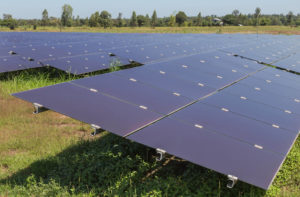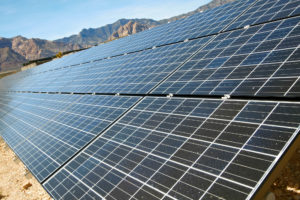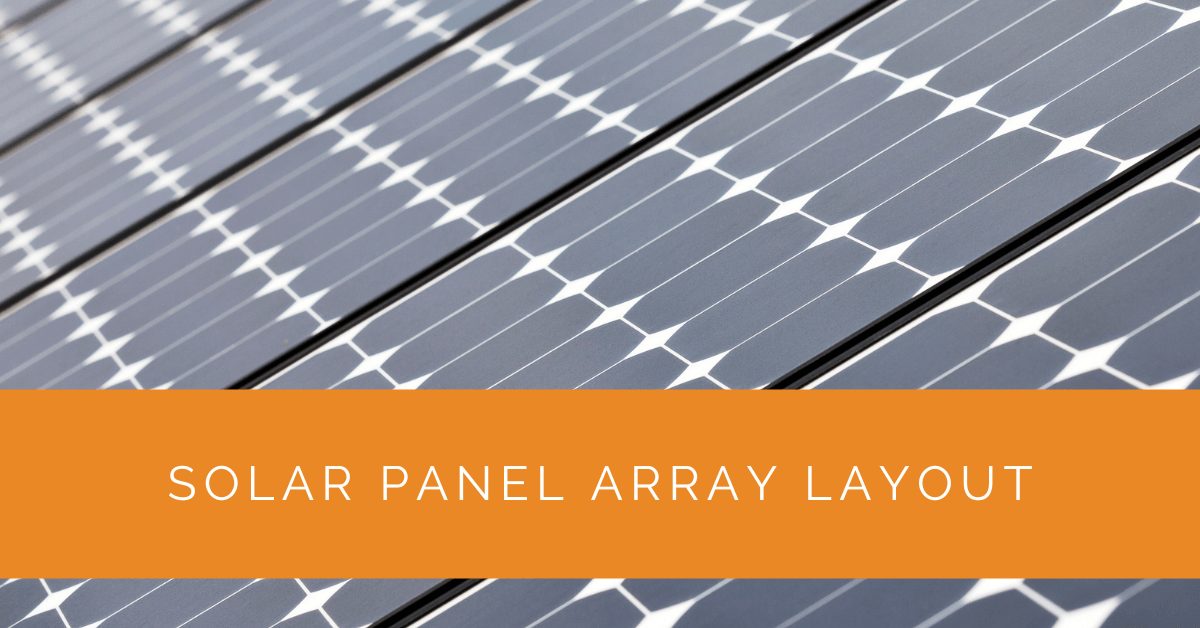Solar power has become an increasingly popular and environmentally friendly source of energy. One of the critical aspects of harnessing solar energy efficiently is the layout of your solar panel array. Proper design and placement of solar panels can significantly impact the electricity generated and your return on investment. In this comprehensive guide, we’ll delve into the intricacies of solar panel array layout to help you make the most out of your solar photovoltaic (PV) system.
Contents
- 1 Key Takeaways
- 2 Key Components of a Solar Panel Array
- 3 Roof Selection
- 4 Solar Array Layout Efficiency Calculator
- 5 Factors to Consider When Designing a Solar Panel Array
- 6 Case Study: Optimizing Solar Panel Array Layout for Maximum Efficiency
- 7 Expert Insights From Our Solar Panel Installers About Solar Panel Array Layout
- 8 Experience Solar Excellence with Us!
- 9 Conclusion
Key Takeaways
- Proper solar panel array layout is crucial for maximizing energy generation in solar photovoltaic (PV) systems. This involves selecting the right components, such as high-quality solar panels and appropriate mounting systems.
- Factors like the optimum size, grid connection, and shade analysis must be carefully considered to ensure efficiency and compliance with utility requirements when designing a solar panel array.
- Commercial and industrial solar panel arrays require additional attention to details such as ballast systems, electrical interconnection, and local regulations, making professional expertise essential for successful installations.
Key Components of a Solar Panel Array
Solar Panels and Modules
When discussing the key components of a solar panel array, it’s crucial to delve deeper into the role of solar panels and PV modules. Solar panels, often called photovoltaic (PV) panels, are the fundamental building blocks of a solar energy system. These panels are constructed from numerous solar cells that convert sunlight into electricity.
PV modules consist of multiple interconnected solar cells housed within a single frame. The efficiency and performance of solar panels depend on the quality of these modules. High-quality modules are designed to capture more sunlight and generate more electricity, ensuring optimal energy production over the long term.
Additionally, there are different types of solar panels to consider, such as monocrystalline, polycrystalline, and thin-film. Each type has its advantages and drawbacks, and choosing the right one for your solar array is a crucial decision that can impact energy output and overall system longevity.
Mounting Systems
Mounting systems are pivotal in a solar panel array’s overall design and efficiency. These systems are responsible for securing the solar panels, ensuring they are properly oriented to capture maximum sunlight, and withstanding environmental factors such as wind and snow loads.
Fixed-Tilt Mounting Systems
Fixed-tilt mounting systems are stationary and maintain a fixed angle throughout the year. They are well-suited for regions with consistent sun angles but may not optimize energy generation during seasonal variations. These systems are simple and cost-effective.
Adjustable-Tilt Mounting Systems
For locations with varying sun angles, adjustable-tilt mounting systems offer flexibility. You can change the tilt angle of the panels seasonally to maximize energy capture during different times of the year. While these systems require more maintenance, they can significantly boost overall energy production.
Tracking Systems
Tracking systems, including single-axis and dual-axis trackers, dynamically follow the sun’s path throughout the day. This dynamic movement allows solar panels to remain aligned with the sun, optimizing energy capture. Although tracking systems are more complex and costly, they are highly efficient and particularly beneficial in regions with substantial seasonal sun-angle variations.

Roof Selection
Selecting the right rooftop for your solar panel array is a pivotal decision that requires careful consideration. The choice of roof impacts the system’s performance, longevity, and overall return on investment.
Roof Orientation and Angle
Orientation refers to the direction your roof faces in relation to the sun. South-facing roofs typically receive the most sunlight throughout the day, making them ideal for solar panel installations. However, east and west-facing roofs can also be suitable with minor adjustments in panel placement. Roof angle, or pitch, also affects energy production. The angle should be optimized to align with your location’s latitude.
Structural Integrity
Your chosen roof must have the structural integrity to support the weight of the solar panels, mounting systems, and other components. Consult a structural engineer to ensure your roof can withstand the additional load.
Shade Analysis
Before installing solar panels, conduct a comprehensive shade analysis to identify potential sources of shade, such as trees, nearby buildings, or other obstructions. Shade can significantly reduce energy generation, so addressing and mitigating shading issues is essential.
Solar Array Layout Efficiency Calculator
Estimate how your roof layout affects solar energy production.
Factors to Consider When Designing a Solar Panel Array
Optimum Size of the Overall Array
Determining the appropriate size of your solar panel array is a critical step in the design process. An oversized array can be costly and inefficient, while an undersized one may not meet your energy needs. Several factors influence the optimal size of your solar system:
- Energy Consumption: Start by analyzing your historical energy consumption to gauge your electricity needs accurately. Consider factors such as seasonal variations in energy use.
- Available Roof Space: The available roof space and its orientation play a significant role in determining the array’s size. Calculate the maximum number of panels your roof can accommodate while adhering to safety and aesthetic considerations.
- Budget: Your budget will influence the size of the solar array. Determine how much you will invest in your solar energy system and balance it with your energy goals.

Grid Connection and Utility Requirements: Going Grid-Tied
Most solar panel arrays are connected to the electrical grid, allowing for the exchange of electricity between your system and the utility company. Here are some key considerations in this regard:
- Interconnection Agreements: Contact your utility company to understand their interconnection requirements and any necessary agreements. Compliance with utility regulations is essential for a seamless connection.
- Net Metering: Investigate net metering policies in your area. Net metering allows you to earn credits for excess electricity your system feeds back into the grid, which can lead to significant savings on your energy bills.
- Permits and Inspections: Be prepared to obtain the required permits and undergo inspections to ensure your system meets safety and code standards.
Shade Analysis and Mitigation: Sunlight Is Key
Shade analysis is not limited to roof selection; it also applies to the layout of your solar panel array. Here’s how to handle shade-related considerations:
- Site-Specific Analysis: Conduct a site-specific shade analysis to identify potential obstructions that may cast shadows on your panels throughout the day and seasons.
- Panel Placement: Optimize the placement of your solar panels to minimize shade impact. This may involve adjusting the tilt angle and spacing or considering partial shading-tolerant panel technologies.
Commercial and Industrial Considerations: Scaling Up for Success
For commercial and industrial installations, additional factors come into play due to the larger scale and higher energy demands:
- Ballast Systems for Flat Roofs: Flat roof installations often require ballast systems to secure the panels without penetrating the roof membrane. Understanding ballast requirements is crucial for these installations.
- Electrical Interconnection: Commercial and industrial systems involve complex electrical interconnections, including transformers, switchgear, and distribution systems. Consulting with electrical engineers is essential to ensure electricity’s safe and efficient flow.
- Local Regulations: Be aware of local regulations and zoning codes that may impact your solar panel array design. Compliance with these regulations is critical for a smooth installation process.
Case Study: Optimizing Solar Panel Array Layout for Maximum Efficiency
Background
A residential client approached us with the goal of installing a solar PV system on their property. They wanted to maximize energy production while ensuring the system’s longevity and efficiency. The client was also interested in leveraging net metering to reduce their electricity bills.
Project Overview
Our objective was to design and install a solar panel array that maximized energy output, adhered to local regulations, and provided substantial cost savings through net metering. We conducted a detailed site assessment to determine the optimal layout for the solar panels.
Implementation
- Site Assessment and Customization: We began by evaluating the roof’s orientation, angle, and available space. This included conducting a comprehensive shade analysis to identify potential obstructions. Based on this assessment, we recommended using high-efficiency monocrystalline panels and an adjustable-tilt mounting system to optimize energy capture throughout the year.
- Array Size Determination: The client’s historical energy consumption data was analyzed to determine the appropriate size of the solar array. We balanced their energy needs with their budget, ensuring the system was neither oversized nor undersized.
- Proper Cable Installation Techniques: We meticulously installed the cables, avoiding sharp bends and kinks to minimize resistance and voltage drop. Proper termination and connection techniques were employed to ensure efficient power transmission.
- Shade Mitigation Strategies: To mitigate shading issues, we adjusted the panel placement and tilt angle. We also considered partial shading-tolerant panel technologies to ensure consistent energy production even in less-than-ideal conditions.
- Grid Connection and Net Metering: We worked closely with the local utility company to ensure compliance with interconnection agreements and net metering policies. All necessary permits were obtained, and inspections were conducted to meet safety and code standards.
- Leveraging MPPT Technology: Maximum Power Point Tracking (MPPT) technology was integrated into the system’s inverters to enhance energy capture and minimize losses due to voltage drop.
Results
- Enhanced Energy Production: The optimized layout and high-efficiency panels significantly boosted energy production. The client reported a noticeable increase in the system’s output, translating to substantial energy savings.
- Cost Savings: By leveraging net metering, the client was able to offset their electricity bills, achieving a quicker return on investment. The initial costs of the system were recouped faster than anticipated due to the enhanced efficiency and savings on utility bills.
- Improved System Longevity: The use of high-quality mounting systems and proper installation techniques ensured the system’s durability. The client experienced fewer maintenance issues and consistent performance, even in adverse weather conditions.
- Environmental Impact: The optimized solar panel array not only reduced the client’s reliance on grid electricity but also contributed to a significant decrease in their carbon footprint. This installation underscored the environmental benefits of well-designed solar PV systems.
Summary
This residential installation case study highlights the importance of an optimized solar panel array layout. Through careful planning, site assessment, and the use of advanced technologies like MPPT, we maximized energy production and ensured the system’s efficiency and longevity. The client’s investment in solar energy resulted in substantial cost savings and a reduced environmental impact, demonstrating the value of expert design and installation in achieving solar excellence.
Expert Insights From Our Solar Panel Installers About Solar Panel Array Layout
Proper layout is the cornerstone of an efficient solar PV system. Ensuring the right orientation and tilt of panels can significantly boost energy production, making your investment pay off faster.
Senior Solar Engineer
Shading can drastically reduce the efficiency of a solar panel array. Conducting a thorough shade analysis and adjusting panel placement accordingly is crucial to maximizing output.
Lead Solar Technician
High-quality mounting systems not only ensure the structural integrity of the solar array but also enhance the system’s longevity and performance under various environmental conditions.
Installation Manager
Experience Solar Excellence with Us!
Trust in Solar Panels Network USA, where our seasoned experts deliver top-quality solar solutions for homes and businesses nationwide. With a legacy of countless successful installations and a commitment to sustainable energy, we’re your reliable partner in the solar journey. Ready for a brighter, eco-friendly future? Call us now at (855) 427-0058 and harness the power of the sun!
Conclusion
Personal experience and expertise truly come into play when you design your solar panel array layout. Over the years, we have witnessed the transformative impact solar photovoltaic (PV) systems can have on energy generation and sustainability. Our journey has taught us that choosing the right components, such as high-quality solar panels and appropriate mounting systems, is essential to maximize energy production.
In the world of solar array design, we’ve come to understand that every factor, from the size of the array to grid connection and utility requirements, plays a vital role. Our expertise has been honed through countless installations, where we’ve seamlessly interconnected our systems with the grid, often taking advantage of net metering policies to provide substantial energy savings. We invite you to embark on your solar journey with the knowledge that a well-designed solar panel array is an investment that goes beyond economics. It’s a commitment to a brighter and cleaner future—one where you can confidently harness the sun’s energy, just as we have in our journey towards solar excellence.
About the Author
Solar Panels Network USA stands at the forefront of solar energy solutions, driven by a team of seasoned solar engineers and energy consultants. With over decades of experience in delivering high-quality solar installations and maintenance, we are committed to promoting sustainable energy through customer-centric, tailored solutions. Our articles reflect this commitment, crafted collaboratively by experts to provide accurate, up-to-date insights into solar technology, ensuring our readers are well-informed and empowered in their solar energy decisions.

